
The Province of L'Aquila is the largest, most mountainous and least densely populated province of the Abruzzo region of Southern Italy. It comprises about half the landmass of Abruzzo and occupies the western part of the region. It has borders with the provinces of Teramo to the north, Pescara and Chieti to the east, Isernia to the south and Frosinone, Rome and Rieti to the west. Its capital is the city of L'Aquila.

The province of Pescara is a province in the Abruzzo region of Italy. Its provincial capital is the city Pescara, which has a population of 119,483 inhabitants. As of 2017, it has a total population of 319,936 inhabitants over an area of 1,230.33 square kilometres (475.03 sq mi). The provincial president is Antonio Zaffiri and the province contains 46 comuni.

The Aterno-Pescara is a river system in Abruzzo, eastern central Italy. The river is known as the Aterno near its source in the mountains, but takes the name Pescara, actually a tributary, nearer the city of Pescara and the Adriatic Sea.

The Agri is a river in the Basilicata region of southern Italy. In ancient times it was known as Aciris. The source of the river is in the Lucan Apennines north of Monte Volturino and west of Calvello in the province of Potenza. It is near the source of the Basento. The river flows south near Paterno before curving southeast. It flows near Tramutola, Viggiano, and Grumento Nova before entering a lake. After exiting the lake, the river flows eastward near Armento, Missanello, Aliano, and Sant'Arcangelo. A right tributary, the Racanello, enters the river in this area. The river forms the border between the province of Potenza and the province of Matera for part of this area of the river. It flows into a small lake before entering the province of Matera. The river flows for a short distance before entering Lago di Gannano. After exiting the lake, the river flows southeast near Tursi, Montalbano Jonico, and Scanzano Jonico before flowing into the Gulf of Taranto near Policoro.

Scanno is a town and district in the province of L'Aquila, in the Abruzzo region of central Italy.

Bugnara is a comune and village in the province of L'Aquila in the Abruzzo region of central Italy. In 2007, it was designated as one of the most beautiful villages in Italy, an association that notes small Italian towns of artistic and historical interest.

Goriano Sicoli is a comune and town in the Province of L'Aquila in the Abruzzo region of Italy.

The Tronto is a 115-kilometre (71 mi) long Italian river that arises at Monti della Laga and ends in the Adriatic Sea at Porto d'Ascoli, San Benedetto del Tronto. It traverses the Lazio, Marche, and Abruzzo regions of Italy.

The Botanical Garden at the Sorgenti del Cavuto is a botanical garden in Anversa degli Abruzzi, province of L'Aquila, Abruzzo, central-southern Italy. The garden was established in 1999, and is managed by the municipality of Anversa degli Abruzzi in agreement with the World Wide Fund for Nature. It contains about 380 native plant species, of which 45 are classified as endangered.
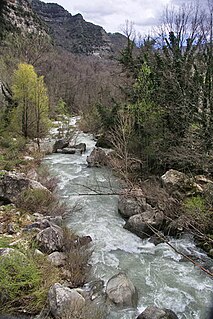
The Vomano is a 76 km river, which is in the Abruzzo region of Italy. Its source is near Monte San Franco in Gran Sasso d'Italia and Lago di Campotosto in the province of L'Aquila. The river crosses the border into the province of Teramo and flows northeast near Montorio al Vomano and Basciano. The Fucino flows into the Vomano south of Crognaleto and the Mavone flows into the Vomano near Basciano. It enters the Adriatic Sea near Roseto degli Abruzzi.
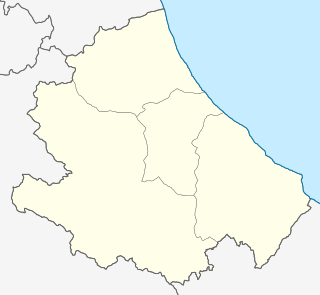
Lago di Scanno is a lake in the Province of L'Aquila, Abruzzo, Italy. It is located in the Appennino Abruzzese north of Parco Nazionale d'Abruzzo, Lazio e Molise. On its southern shore is Scanno and on its northern shore is Villalago. The Sagittario flows out of the lake towards the north. The part of the Sagittario river that flows into the lake from the south is known as the Tasso.
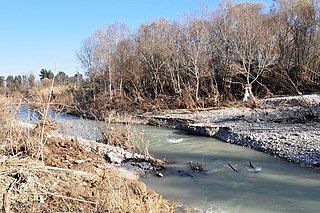
The Saline is a river in the province of Pescara in the Abruzzo region of Italy The river is formed by the confluence of the Fino and Tavo rivers. It flows northeast and enters the Adriatic Sea near Montesilvano and Città Sant'Angelo.

The Piomba is an Italian river in Abruzzo. The source of the river is near Cermignano in the province of Teramo. The river flows southeast past Cellino Attanasio before entering the province of Pescara. The river flows close to the border with Teramo before it enters the Adriatic Sea north of the mouth of the Saline and south of Silvi.
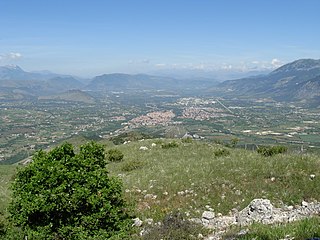
The Valle Peligna, also known as Conca di Sulmona, is a plateau in central Abruzzo, southern Italy, included in the province of L'Aquila. It has a surface of some 100 km².
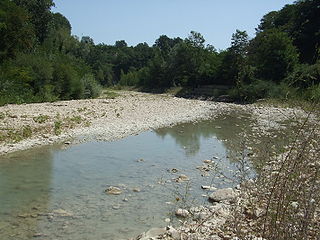
The Fino is a river in eastern central Italy. Its source is near Monte Camicia in the province of Teramo in the Abruzzo region of Italy. The river flows northeast and then curves east before flowing past Bisenti. It continues flowing eastward and crosses into the province of Pescara near Elice. The river flows southeast until it joins the Tavo river and the two rivers become the Saline river.
The Tavo is a river in the Abruzzo region of Italy. Its source is in the Gran Sasso d'Italia mountain range in the province of L'Aquila near the border with the province of Pescara. After crossing the border, the river loops northward and then eastward near Penne. It then flows south and then northeast and flows near Loreto Aprutino and Pianella. The river continues flowing northeast near Cappelle sul Tavo before joining the Fino and together they become the Saline.
The Foro is a river in Italy. It is located in the province of Chieti in the Abruzzo region of southern Italy. Its source is located in Maiella National Park near the border with the province of Pescara. The river flows northeast past Fara Filiorum Petri before flowing into the Adriatic Sea between Francavilla al Mare and Ortona.
The Gizio is a river in Italy. It is located in the province of L'Aquila in the Abruzzo region of southern Italy. The river is the main tributary of the Sagittario. Its source is located near Rocca Pia and Pettorano sul Gizio. The river flows north through the Appennino Abruzzese near Sulmona before entering the Sagittario.

The Alento is a river in Italy. It is located in the Abruzzo region of southern Italy. Its source is located in Maiella National Park in the province of Pescara.

The Salinello is a river in Italy. It is located in the province of Teramo in the Abruzzo region of southern Italy. The source of the river is in the Monti della Laga range southwest of Montagna dei Fiori. The river flows eastward and curves northeast near Civitella del Tronto. The river then curves southeast near Sant'Egidio alla Vibrata and the border with the province of Ascoli Piceno. Finally, the river flows east near Sant'Omero and enters the Adriatic Sea near Giulianova and Tortoreto Lido.

















